How a Community-Driven Meeting Led to Results in Houston
Collaboration doesn’t just happen.
As my good friend and colleague Carlos Valdes-Dapena says, “Collaboration is the result of design.”
An article published in June 2022 in The New York Times—How Houston Moved 25,000 People From the Streets Into Homes of Their Own—celebrates the city of Houston for doing “twice as well as the rest of the country at reducing homelessness over the previous decade,” according to a 2020 federal report. It goes on to report that “Houston has gotten this far by teaming with county agencies and persuading scores of local service providers, corporations and charitable nonprofits…. to row in unison.”
The Coalition for the Homeless of Houston/Harris County is the organization contracted and credited for bringing together more than 100 local and regional organizations.
But how did they do it?
The answer is intentional and consistent collaboration, starting with whole-systems intervention.
A whole systems intervention is a process or approach for addressing a need, challenge or goal that impacts many parts of an organization or a community. Using a whole systems approach means bringing together representative stakeholders or an entire community to co-create solutions that will work best for their unique challenges. A whole systems approach assumes that “the knowledge is the room.” In other words, participants already have everything they need in order to create a successful solution, idea or initiative. All they need is a path to get them there and a guide to show them the way.
For more about whole systems facilitation, check out our blog on Dancing with Markers—Facilitation Design for Whole Systems.
What We Did
In November 2018, my colleague Brian Tarallo and I partnered on an Open Space-style conference—one version of a whole systems approach—in partnership with the Coalition for the Homeless of Houston and Brian’s company Lizard Brain. Around 160 community members, social service providers, faith leaders, policymakers, and people experiencing homelessness participated. We worked closely with the Houston-based team of consultants to consider several possible approaches and landed on Open Space as the best way to accommodate the maximum number of topics and conversations.
What’s Open Space? To find out and learn how you can use it to facilitate, check out Season One, Episode Six of our podcast This Meeting Sucks, where we go in-depth on how we use this tool to maximize meeting outputs and group potential.
Several discussion topics were determined in advance through community interviews. After a brief energizer and introduction activity, participants introduced topics and began conversation sessions. Around 50 different topics were discussed throughout the day. Participants captured notes on flipcharts, and all notes and flipcharts were compiled and reported back to the planning committee which incorporated them into their strategic plans.
This was just a single event in a dedicated collaboration effort, but it’s easy to see how an event like this can get many people, organizations and systems moving in an aligned direction. Rather than competing for resources, they began combining them. Rather than fighting over who had the best idea, they began to build on their ideas to make better ones.
What to Take Away
Your organization’s mission and who you’re serving is the great equalizer. When you experience conflict in meetings, bringing the group back to what matters to everyone is the fastest way to build on each other’s thoughts and ideas rather than cutting them down.
This tale of Houston is a prime example of the impact you can have when a whole city begins to “row in unison.”
Interested in creating a similar experience for your organization or initiative? Reach out to us today to start the conversation.


